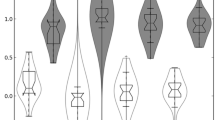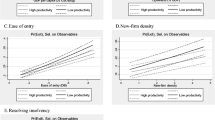Abstract
In this evolutionary model, random shocks create differences in the rate of return on capital, while individual saving and investment behavior can reduce these differences over time. Firms with either low total factor productivity (TFP) or a low average return on capital are selected for exit, and new firms enter to take their place. As would be expected, a higher turnover rate improves TFP and reduces its variation. While we show that a higher turnover rate would result in a more positively skewed TFP distribution if exit selection is based directly upon TFP, we find that when we select firms for exit based on their average product of capital, the marginal impact of a higher turnover rate is to more negatively skew the TFP distribution. Overall, our simulations highlight the importance of considering the role selection may play in shaping the distribution of productivity when econometricians seek estimates of firm inefficiency.





Similar content being viewed by others
Notes
In doing so, we are following Jovanovic (1982), who cites evidence that small firms grow faster than large firms but are also more likely to fail, and creates a model of “‘noisy’ selection” to explain why.
As of June, 2001, when this research began, Econlit listed 217 citations for the stochastic frontier approach since 1977, and 365 citations for the data envelopment approach since 1985. In the past few years, citations for the former approach are around half those for the latter approach, suggesting that the former method is gradually being replaced by the latter.
See, for example, Ericson and Pakes (1995) for a description and model of this process.
Cargill and Parker (2002) used a simulation of a Walrasian tattonment process, but it is computationally demanding.
Parker (1995) and Cargill and Parker (2002) assumed that this shock was exponentially normal, of the form \(a_{{it}} = a_{{i,t - 1}} \;e^{{\varepsilon _{{it}} }}\). While this has the benefit of ensuring that TFP is always positive, it biases the results towards a positive skew. However, we tested the simulation in Section 4 by re-running it with the exponential shock; in re-estimating the response function, we found the marginal effects not significantly affected.
Of course, bankruptcy as a legal process is rarely so optimal. Managers may be willing to continue operating a loss-making firm if they can hide information on the firm’s poor long-run potential from the owners. Creditors with first priority of repayment may force a potentially productive firm to liquidate to ensure that they do not have to accept a loss on their investment.
We chose 20 iterations because it was long enough to observe changes in the distribution of productivity. We also tested whether our results were sensitive to this duration by rerunning our results for 50 iterations. While coefficient values obviously changed, the sign and statistical significance of these coefficients, as reported in Tables 3, 4, and 5, did not change in either the end or trend regressions.
We thank the editor for raising the issue of changing the number of firms. An interesting extension of this work would be to change the assumptions of the model so that the number of firms is endogenously determined, say by replacing constant returns to scale with decreasing returns. Then, one could systematically examine how changing the economic environment not only changes the number of firms in an economy with selection, but also changes the mean, variance and skew of total factor productivity.
The changes in these preference parameters did not significantly influence the results.
We simulated the estimation of current consumption with different parameter sets for many values of Z. We found that consumption estimates were wildly unstable for values of Z below 5, so the stable arm of the growth path is clearly not linear. However, for Z≥10, we found that the consumption estimates started to converge asymptotically. The estimates obtained for Z=25 were very close to the estimates for T=10,000.
Each case is a separate simulation, and small differences are to be expected due to differences in the random shocks.
References
Aigner D, Lovell CA CAK, Schmidt P (1977) Formulation and estimation of stochastic frontier production function models. Journal of Econometrics 6:21–37
Alchian AA (1950) Uncertainty, evolution, and economic theory. Journal of Political Economy 63:211–221
Barro RJ, Sala-I-Martin X (1995) Economic Growth. McGraw-Hill, New York
Bartelsman EJ, Dhrymes P (1998) Productivity dynamics: U.S. manufacturing plants, 1972–1986. Journal of Productivity Analysis 9:5–34
Cargill TF, Parker E (2002) Asian finance and the role of bankruptcy: a model of the transition costs of financial liberalization. Journal of Asian Economics 13:297–318
Carree MA (2002) Technological inefficiency and the skewness of the error component in stochastic frontier analysis. Economic Letters 77:101–107
Cass D (1965) Optimum growth in an aggregative model of capital accumulation. Review of Economic Studies 32:233–240
Charnes A, Cooper WW, Rhodes E (1978) Measuring the efficiency of decision-making units. European Journal of Operational Research 3:392–444
Dwyer DW (1998) Technology locks, creative destruction, and non-convergence in productivity levels. Review of Economic Dynamics 1:430–473
Ericson R, Pakes A (1995) Markov-perfect industry dynamics: a framework for empirical work. Review of Economic Studies 62:53–82
Foster L, Haltiwanger J, Krizan CJ (1998) Aggregate productivity growth: Lessons from microeconomic evidence. NBER, working paper 6803, Cambridge, MA, USA
Giannakas K, Tran KC, Tzouvelekas V (2003) On the choice of functional form in stochastic frontier modeling. Empirical Economics 28:75–100
Green A, Mayes D (1991) Technical inefficiency in manufacturing industries. Economic Journal 101:523–538
Jovanovic B (1982) Selection and the evolution of industry. Econometrica 50:649–670
Koopmans TC (1965) On the concept of optimal economic growth. In The Economic Approach to Development Planning. Elsevier, Amsterdam
Kumbhakar SC, Orea L (2004) Efficiency measurement using a latent class stochastic frontier, Empirical Economics 29:169–183
Levinsohn J, Petrin A (1999) When industries become more productive, do firms? Investigating productivity dynamics. NBER, working paper 6893, Cambridge, MA, USA
Montgomery E, Wascher W (1988) Creative destruction and the behavior of productivity over the business cycle. Review of Economics and Statistics 70:168–172
Parker E (1995) Schumpeterian creative destruction and the growth of Chinese enterprises. China Economic Review 6:201–223
Pinker S (1997) How the mind works. W.W.Norton, New York
Ramsey FP (1928) A mathematical theory of saving. Economic Journal 38:543–559
Rigby DL, Essletzbichler J (2000) Impacts of industry mix, technological change, selection and plant entry/exit on regional productivity growth. Regional Studies 34:333–342
Author information
Authors and Affiliations
Corresponding author
Rights and permissions
About this article
Cite this article
Parker, E., Pingle, M. The distributional effects of selection and capital accumulation on firm productivity under imperfect capital markets. Empirical Economics 31, 677–697 (2006). https://doi.org/10.1007/s00181-005-0046-1
Received:
Accepted:
Published:
Issue Date:
DOI: https://doi.org/10.1007/s00181-005-0046-1




